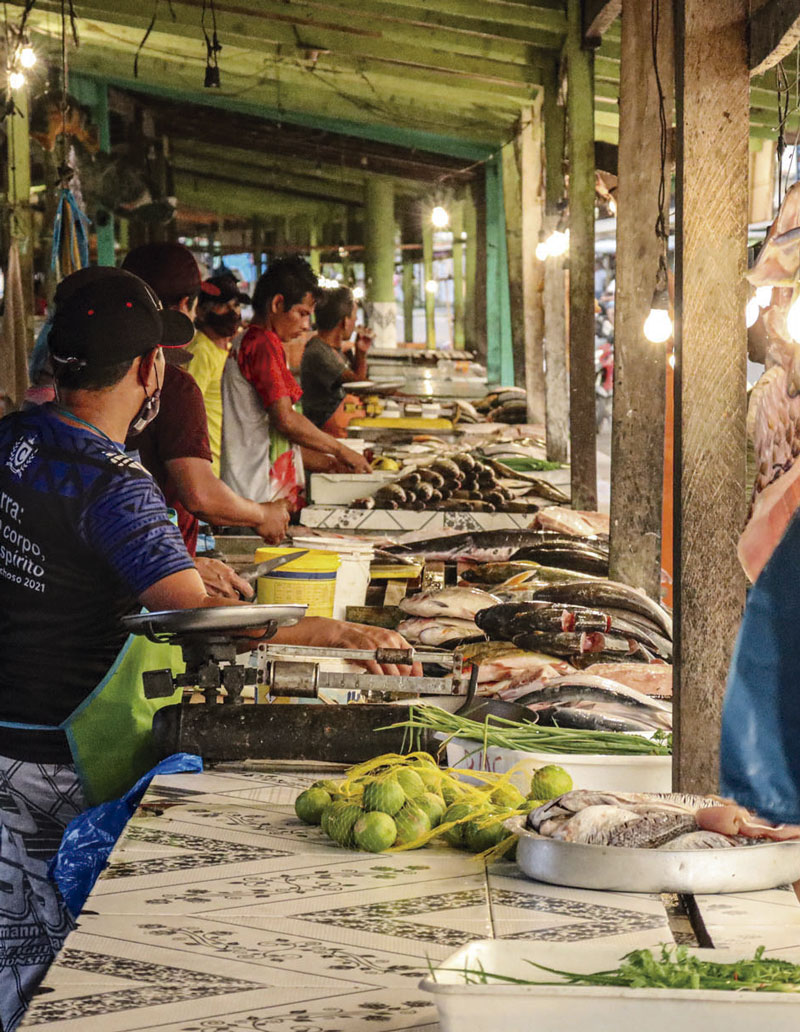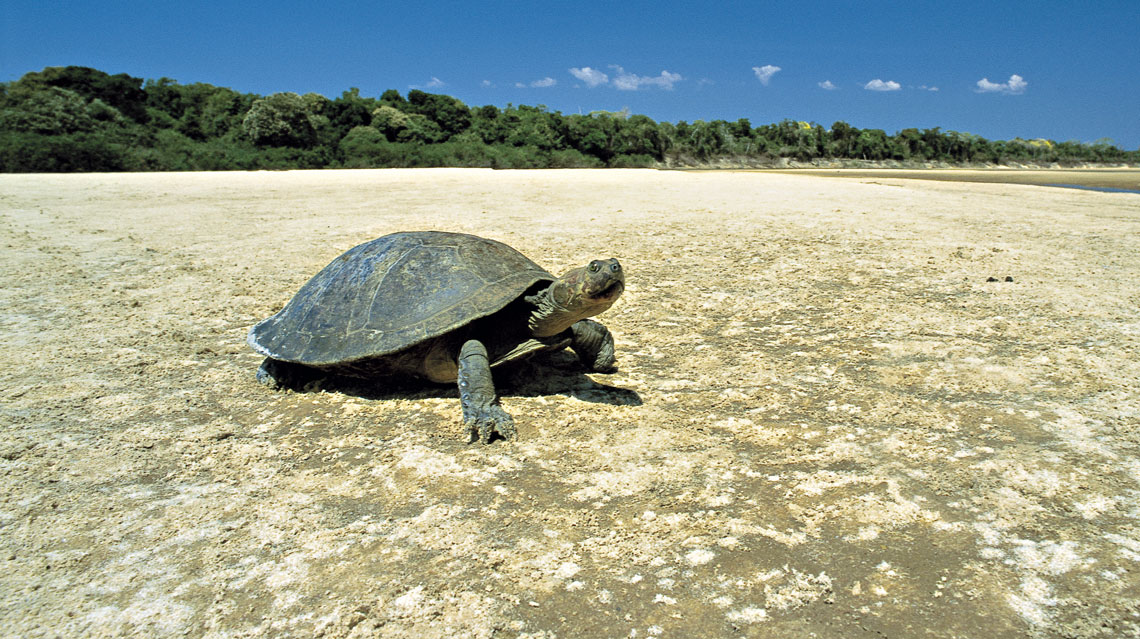Researchers from several Brazilian states and European countries will be immersing themselves in the Amazon over the next three years to collect data on vegetation and climate, samples of biological and mineral material, and Indigenous and traditional cultural pieces from the Amazon region, in a concentrated effort to enhance knowledge about the biological and social diversity present in the planet’s largest rainforest. A call for proposals open until April 29 will invest around R$96 million in funding the organizational and logistical costs of scientific expeditions in areas of the Amazon that are largely unknown and uncharted by researchers.
This call for proposals is the second launched by the Amazon+10 Initiative, which started as a joint effort by the State Funding Agencies (FAPs) for the nine states in the Amazon region and FAPESP (hence the +10), which has since expanded, comprising funding agencies from 25 Brazilian states. The National Council for Scientific and Technological Development (CNPq), the federal government’s main state funding agency, will invest nearly R$30 million in the call for proposals, and funding agencies from countries such as the United Kingdom, Germany, and Switzerland will contribute R$37 million, with 19 FAPs investing R$29.2 million. The expeditions will be led by multidisciplinary teams coordinated by researchers from at least two Amazonian states. The Indigenous peoples and quilombolas must be involved as representatives of those that hold the traditional knowledge studied during the expeditions.

Liam Cavalcante / Amazônia RealSelling fish at a market in Parintins, in Amazonas: knowledge of natural resources can generate wealthLiam Cavalcante / Amazônia Real
Amazon+10 was launched in 2021, when announced in Glasgow, Scotland, during the 26th United Nations Climate Change Conference, in the wake of the São Paulo state government’s willingness to invest funds to support research projects in the Amazon at a time when institutions in the region were suffering from a lack of project and grant funding. The then Secretary of Economic Development, Science, and Technology for the State of São Paulo, Patrícia Ellen, who at the time oversaw the National Council of Secretaries for Science, Technology, and Innovation (CONSECTI), approached FAPESP regarding the opportunity to organize this effort. FAPESP, which in recent decades has invested over R$500 million in projects related to the Amazon, led by researchers from São Paulo, suggested creating research networks with institutions from various states in the Amazon region.
In December 2021, FAPESP, in partnership with CONSECTI, drafted the proposal for creating Amazon+10 and presented it at a meeting held by the National Council of State Funding Agencies (CONFAP) in Foz do Iguaçu. The proposal was enthusiastically received and unanimously approved. FAPESP had already proposed bilateral research funding agreements to CONFAP, but this was the first coordinated research funding initiative involving several FAPs.
We arrived at a model, established in the first call for proposals, based on supporting collaborative projects with researchers from at least three states, one of which must be within the Amazon region. The projects are divided into three main areas of interest: the Amazon region, the people who live in the rainforest and the region’s cities, and strengthening sustainable production chains. “The model was well received, and we ultimately got 20 FAPs to join in during the first call for proposals, each funding researchers in their state,” explains Odir Dellagostin, president of CONFAP, who coordinated the initiative alongside CONSECTI. He highlights that this was the first time that so many state agencies had worked together. “The FAPs have quite a bit of experience with bilateral cooperation, including with international institutions, but never with several states at the same time,” he notes. The CNPq participated in the first call for proposals by supplementing the funds invested by states that lacked sufficient resources to fund all approved projects, such as Acre, Amapá, and Pará.

Alberto César Araújo / Amazônia RealFlooding of the Rio Negro in a rural area of Manaus: traditionally, data collection on the Amazon has been concentrated to roadsides and waterwaysAlberto César Araújo / Amazônia Real
Rafael Andery, Executive Secretary of the Amazon+10 Initiative, says that one of the inspirations behind the framework used in the first call for proposals were those issued by the Belmont Forum, a group comprising 27 funding institutions from several countries, including FAPESP, which jointly fund research projects on environmental changes. One concern was ensuring that the projects addressed issues that impact society in Amazonian states. “One condition we established was that the projects should seek to impact development in the region,” explains Marcel Botelho, director of the Pará State Funding Agency (FAPESPA) and who is a member of the initiative’s executive board along with Chief Executive Officer of the FAPESP Executive Board, Carlos Américo Pacheco, and President of the State Funding Agency of Amazonas (FAPEAM), Márcia Perales.
“We believe it is vital to look below the forest canopy, which is where the Amazonians live,” says Botelho, in response to research based on satellite images depicting the Amazon from above the treetops. The scientific expeditions will also focus on the economic impact of the study’s findings. “Today, what we know of the Amazon is what occurs on the banks of rivers and along the roads. We know of, at most, 300 fish species in the Amazon, but that is probably only 10% of what exists. Expanding this knowledge could help generate wealth for the region.
The first call for proposals was open between July and August of 2022 and surprised us with the number of projects submitted: 152 in total. Thirty-nine projects were selected, totaling almost R$42 million in investments, covering topics such as biodiversity, climate change, bioeconomy, land use, and improving living conditions in the Amazon region. Of this total, FAPESP invested R$14.6 million in 20 projects involving researchers from the state of São Paulo. The Amazonas and Pará agencies invested, respectively, R$7.1 million and R$5.3 million during the call for proposals, followed by the Rio de Janeiro State Funding Agency (FAPERJ), with R$5.2 million. “The call had three objectives that were successfully met,” says Andery. “We managed to inject emergency funds into the Amazonian science and technology network during a time of acute shortage, we mapped the research networks that existed and, despite the incredibly short deadlines for submitting proposals, we also helped form some new networks.”

Léo Ramos Chaves / Pesquisa Fapesp Açaí orchards in inland Pará: different fruits from the rainforest can boost the bioeconomyLéo Ramos Chaves / Pesquisa Fapesp
Biologist Carlos Alfredo Joly, of the University of Campinas (UNICAMP), who led scientific analyses of the initiative’s projects funded by FAPESP, says that groups already active in the region were included in the first call for proposals. “As there was little time to submit proposals, teams with experience researching the Amazon found it easier to participate,” he explains. Some projects, notes Joly, are the offspring of another major research effort in the region: the Large-Scale Biosphere-Atmosphere Experiment in Amazônia (LBA), created in 1998.
One example of this is a project focusing on the environmental consequences of the rise in aquaculture in the region, compared to the carbon footprint of other types of animal production. The São Paulo-based project coordinator is agronomist Jean Ometto, from the National Institute for Space Research (INPE), who participated in the LBA. There are also a handful of projects in the field of public health and virology. One of the projects features researchers from nine states and seeks to map the diversity of protozoa, viruses, and bacteria and analyze the effects that environmental degradation and changes in land use patterns may have on the reproduction cycles of these pathogens. Another seeks to form a network of researchers to assess how deforestation around the BR-319 highway, in Amazonas, and mining in the Carajás region, in the state of Pará, may influence the spread of emerging viruses.
Studies on the impact of climate change are present in projects such as the one focused on the possibility of using herpetofauna (turtles and other reptiles and amphibians) from the Amazon region as benchmarks for how biodiversity responds to temperature changes. Eight projects focus on studying the value chains of products generated from the rainforest, including fish such as the pirarucu and fruit such as açaí and Brazil nuts. “None of these products, taken in isolation, seem to be strong enough to boost the bioeconomy in the Amazon, but when we see a set of eight initiatives with converging objectives, the chances increase that major contributions will emerge,” says Joly, who stresses the need to invest in training for research groups to ensure that data are collected in a standardized manner and organized properly.

Jose Caldas / Brazil Photos / Lightrocket via Getty ImagesA turtle on Bananal Island, in Tocantins: studies on the effects of climate change on biodiversityJose Caldas / Brazil Photos / Lightrocket via Getty Images
With the return of investments being made in Brazilian science and technology, in 2023, the Amazon+10 Initiative has managed to attract new sources of funding and has expanded its governance. UK Research and Innovation (UKRI), the United Kingdom’s largest funding agency, has made £4 million available for calls for scientific expeditions. “It is a new opportunity for British researchers to work in partnership with their peers in Brazil, to research areas that are not very well known in the Amazon, and to work in solidarity with traditional communities and Indigenous peoples,” says Rossa Commane, Science and Innovation Director for Latin America at the British Embassy in Brazil, in a conversation with FAPESP. A call for proposals to fund workshops by Brazilian and UK researchers on topics covered by the Amazon+10 Initiative, funded by a UK government fund, was open between November 2023 and January 2024—and should release its results soon. Institutions like the Swiss National Science Foundation (SNSF) and the Bavarian Academic Center for Latin America (BAYLAT) also invested in the new call for proposals.
The CNPq also played a leading role. “We have a history of research on the Amazon and our national scope could be useful in driving the initiative forward,” says physicist Ricardo Galvão, president of the CNPq. “Additionally, we are responsible for authorizing foreign scientists’ participation in research in Brazil, which will be necessary during the expeditions.”
Other calls for proposals are due to be issued later this year. One such call will involve a transfer program encouraging doctors to study at research institutions in the Amazon region. “There’s no point in funding studies on the Amazon without training the researchers who will remain in the region and continue to expand knowledge about the rainforest’s social and biological diversity,” says Carlos Joly. “Previous programs, such as the LBA, were not concerned with this and the researchers ended up returning to their home states when their projects concluded.” Another idea is investing in expanding the region’s scientific infrastructure. “If we want to retain researchers, we need to provide them with laboratories where they can work,” says Odir Dellagostin. The initiative should also generate spin-offs. “We already have working groups analyzing the possibility of creating a similar program focused on the Caatinga (semiarid scrublands), a biome with the potential to generate networks among researchers from the Northeast and colleagues from other states,” says CONFAP’s president.
Republish